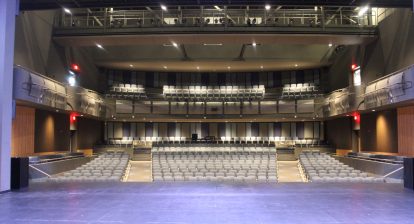May 16, 2016 – Last week, Statistics Canada released a series of economic indicators on arts and culture. The absolute figures – $54.6 billion, 630,000 jobs – are impressive. The trends over time, less so.
The Provincial and Territorial Culture Indicators, 2014 (PTCI) are economic estimates of culture and sport in Canada. They are benchmarked to the more comprehensive Provincial and Territorial Culture Satellite Account, and are projected forward using various macroeconomic indicators. As such they must be interpreted with caution.
According to the PCTI, culture GDP rose 2.8% in 2014 to $54.6 billion, which is 3.0% of the Canadian economy. In the live performance domain, growth was even bigger: 4.7%, reaching $2.5 billion.
| Indicator (product perspective) | Percentage change | ||||||||
| Live performance domain | 2010 | 2011 | 2012 | 2013 | 2014 | 2011 | 2012 | 2013 | 2014 |
| GDP (in million dollars) | 2,064.8 | 2,126.4 | 2,192.8 | 2,354.9 | 2,465.0 | 3.0% | 3.1% | 7.4% | 4.7% |
| Jobs | 53,044 | 54,571 | 54,273 | 56,200 | 54,475 | 2.9% | -0.5% | 3.6% | -3.1% |
It’s easy to get dizzy with such astronomic figures. However, a closer look at the data brings our two feet back on the ground. Here’s a series of critical observations:
- Inflation isn’t factored in. If you take it into account, the culture GDP only rose 0.9% in 2014 and the live performance GDP, 2.7%. In comparison Canada’s real GDP grew 2.5% in 2014 (or 2.2% if you use the same GDP source as the PCTI).
- The live performance GDP (culture perspective) grew at tiny bit faster than Canada’s GDP between 2010 and 2014: 11.1% for live performing arts compared to 10.3% for the Canadian economy (taking inflation into account).
- These indicators (and other data points) seem to suggest that the performing arts weren’t as deeply affected as other sectors by the economic downturn – and that, consequently, live performance GDP followed a pattern of ongoing growth, rather than a pattern of recovery. For the Canadian GDP, the base year, 2010, was a very low benchmark: the increase from 2010 to 2011 was major, and then further increases were more incremental. In comparison, the live performance domain had more regular, linear increases (except for 2013 which, as the survey of household spending also indicated, appears to have been high year for the sector).
- The job indicators are a source of concern. Job growth has been much lower in the Culture sector than in the overall workforce, both in 2014 and over the four-year period. Culture jobs decreased 0.8% in 2014, whereas they increased 0.6% for Canada, according to the Survey of Employment, Payroll and Hours.
- Live performance jobs only grew 2.7% between 2010 and 2014, compared to a national average of 4.7%. This isn’t bad. However, job change for live performance was in the red for 2014: -3.1%.
For the last few decades, we have been able to claim that the arts sector was a job creating sector. These statistics, although they are only projections and over a short period of time, challenge this narrative.
Moreover, it is troubling to the see the live performance GDP increase four times more quickly (11.1% between 2010 and 2014) than the number of jobs (2,7% over the same period). One might interpret this as a rise in labour productivity (and it technically is). However, in a sector subject to the Baumol cost disease, no such significant gain of labour productivity is to be expected. The only plausible explanation is that a few small-in-staff but large-in-ouput segments of our sector are doing much better, whereas others might be in a for a rough ride. In other words, Canadians could have been spending way more for large commercial shows, but less for other types of performances.
This interpretation is highly speculative, and there are unfortunately few other datasets we can look to for some sort of validation. Arts statistics are in danger of extinction. Hence, the sad discontinuation of Hill Strategies‘ Statistical Insights in the Arts series…
We nonetheless hope that this brief analysis will be timely and useful for those who are currently participating in the pre-consultation on Canadian content in a digital world.
Prepared by: Frédéric Julien, Director of Research and Development, CAPACOA
Recent and Related News



